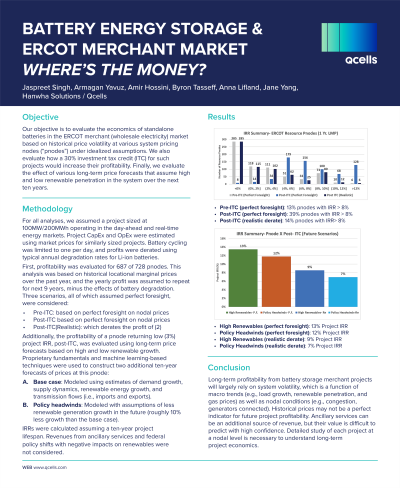Back

Finance and Asset Management
Battery energy storage & merchant markets - where's the money?
Battery energy storage & ERCOT merchant market: where is the money?
Tuesday, September 12, 2023
4:30 PM - 5:30 PM PDT
Location: Poster Area, Booth #11024, Level 1, Venetian Expo Hall

.jpg)
Jaspreet Singh
Director- Product Management
Qcells
San Francisco, California, United States
Poster Presenter(s)
Proposal information to include, objective, methods, results, and conclusion:
Objective: Evaluate the economics of standalone batteries in the ERCOT merchant (wholesale electricity) market based on historical price volatility at various system pricing nodes (“pnodes”) along with impacts of ITC and future scenarios of high renewable penetration
Methodology: All resource pnodes in ERCOT (Texas) were studied assuming a 100 MW/ 200 MWh battery project operating in the day-ahead and real-time energy markets. Project CapEx and OpEx were estimated using market prices. Battery cycling was limited to one per day with typical battery degradation curves. Ancillary services market participation was not considered. Only projects with 8% IRR or higher were considered profitable.
Results: Pnode location was a significant factor in making a project profitable. For Pre-ITC conditions only 13% of pnodes were profitable. In Post-ITC scenario, 40% of pnodes were profitable. Considering a realistic scenario (non-perfect knowledge of market prices), only 14% pnodes were profitable. Considering future market price volatility based on high renewable scenario, a project with low profitability (3% IRR) could return high profits (9-13%) depending on the location.
Conclusion: Long-term profitability from battery storage merchant projects will largely rely on system volatility, which is a function of macro trends (e.g., load growth, renewable penetration, and gas prices) as well as nodal conditions (e.g., congestion, generators connected). Historical prices may not be a perfect indicator of future project profitability. Ancillary services can be an additional source of revenue, but their value is difficult to predict with high confidence. Detailed study of each project at a nodal level is necessary to understand long-term project economics.
Objective: Evaluate the economics of standalone batteries in the ERCOT merchant (wholesale electricity) market based on historical price volatility at various system pricing nodes (“pnodes”) along with impacts of ITC and future scenarios of high renewable penetration
Methodology: All resource pnodes in ERCOT (Texas) were studied assuming a 100 MW/ 200 MWh battery project operating in the day-ahead and real-time energy markets. Project CapEx and OpEx were estimated using market prices. Battery cycling was limited to one per day with typical battery degradation curves. Ancillary services market participation was not considered. Only projects with 8% IRR or higher were considered profitable.
Results: Pnode location was a significant factor in making a project profitable. For Pre-ITC conditions only 13% of pnodes were profitable. In Post-ITC scenario, 40% of pnodes were profitable. Considering a realistic scenario (non-perfect knowledge of market prices), only 14% pnodes were profitable. Considering future market price volatility based on high renewable scenario, a project with low profitability (3% IRR) could return high profits (9-13%) depending on the location.
Conclusion: Long-term profitability from battery storage merchant projects will largely rely on system volatility, which is a function of macro trends (e.g., load growth, renewable penetration, and gas prices) as well as nodal conditions (e.g., congestion, generators connected). Historical prices may not be a perfect indicator of future project profitability. Ancillary services can be an additional source of revenue, but their value is difficult to predict with high confidence. Detailed study of each project at a nodal level is necessary to understand long-term project economics.
